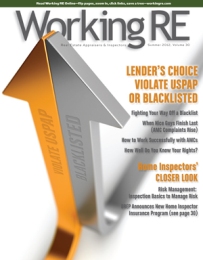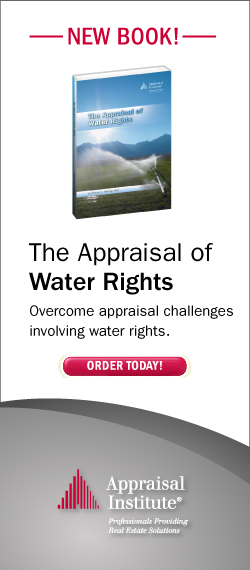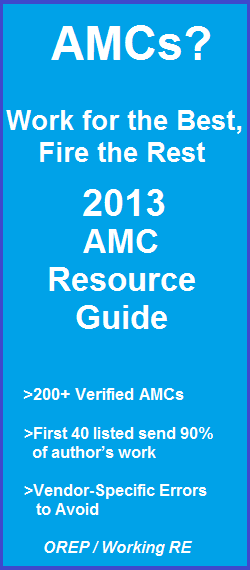
|
Published by OREP, E&O Insurance Experts | October 24, 2012 | Vol. 263 |

|
>
Am I a Working RE Paid
> Blogs > Leave a Comment Below
|
"If you are appraising an environmentally contaminated property, you may need
to consider more than just the cost of remediation (cost to cure). The
property may suffer from stigma associated with the contamination.
Stigmatized properties can take months and even years to recover from a
blighted image.
"
Editor’s
Note:
If
you are appraising an environmentally contaminated property, you may need to
consider more than just the cost of remediation (cost to cure). In this story
excerpted from the upcoming print edition of Working RE, Finigan explains what
to consider when appraising stigmatized properties.
Calculating Diminution of a Contaminated Property
By Francis Xavier Finigan
If you are appraising an environmentally contaminated property, you may need
to consider more than just the cost of remediation (cost to cure). The
property may suffer from stigma associated with the contamination.
Stigmatized properties can take months and even years to recover from a
blighted image.
The Uniform Standards of Professional Appraisal (USPAP) describe
stigma in the A09 provision
(2012-2013)...
“Environmental
Stigma: An
adverse effect on property value produced by the market’s perception of
increased environmental risk due to contamination...When
the appraiser addresses the diminution in value of a contaminated property
and/or its impaired value, the appraiser must recognize that the value of
impacted or contaminated
real estate may not be measurable simply by deducting the remediation or
compliance cost estimate
from the opinion of the value as if unaffected (unimpaired value).”
At first glance most real estate appraisers don't appear to be prepared for
the type of assignment contaminated properties present. Every appraiser
utilizes the same methodologies when they are developing an
opinion of value. The most common and usually the most reliable method for
appraising contaminated residential properties is the
market approach, but we may also need to consider the cost and income approaches in
developing an opinion of value. All three may come into play when
calculating diminution caused by stigma.
Assignments of this nature require considerably more research. To effectively complete an assignment of this sort may cost
thousands of dollars. They typically cannot be priced as a flat fee but should be charged based on an
hourly rate with a cost range
indicated.
Market Approach and Stigma Factor
The most common method used for residential real estate
is the market approach. The three rules of real estate value typically
come into play during the market approach. They are location, location, and
location, but these rules go out the window when appraising a contaminated property.
The most significant factor in choosing comps lies in the type of
contamination. In choosing comps you should choose those that have sold with
the same type of environmental contamination. Today, mold is a very common
environmental contaminant impacting the value of properties everywhere. For
this reason we will use mold contamination as our example.
The first question to ask is how many homes in your neighborhood
are contaminated with the same type of environmental contamination? In
reality, the search for properties contaminated by mold may take the
appraiser to other neighborhoods or even other geographic regions. An
appraiser may
need to conduct as many as four different appraisals in
trying to accurately derive the value of a property rendered uninhabitable
by fungal contamination. All comparables may
be in different geographic markets and require assistance from appraisers in
those regions.
First, the appraiser will need to locate similar properties
suffering from the same type of contamination. Factors
to consider include but are not limited to the type of contamination, the
habitability restrictions specifically attributable to the
contamination and the cost of remediation to cure the defect. This is not as
difficult as it sounds- as more and more contaminated homes emerge,
more information regarding remediation costs is becoming
readily available.
The next
step is to establish a baseline value
for each property (subject and three comparables) by performing a hypothetical
appraisal and developing an opinion of value as if the properties are
not contaminated. Obtain estimates for the cost to cure the contamination at the subject
property.
Research is necessary to determine how much buyers spend to remediate the
environmental conditions. I have found that most people are quite
forthcoming and willing to brag about the good deal they got on the property
and what they spent to remediate. This number represents the actual cost to
cure.
The sale price of
the comp as it sold in the contaminated state plus the new owner’s cost to
cure is then subtracted from the comp's uncontaminated hypothetical value
(baseline). The resulting number is an indication by the marketplace
of the stigma suffered by that property. We can call this the stigma
factor.
Divide the stigma factor by the hypothetical value of each comp to create a
percentage ratio. This is the diminution
ratio suffered by each comparable sale.
A weighted average for the percentage
of loss is created from the three diminution ratios derived from the three
comps. The
average must be weighted based on similarities in property styles,
neighborhoods, or size to the subject property. You have now created a diminution
factor.
Diminution Factor/Impact on Value
The diminution factor is then factored against
the uncontaminated theoretical value of the subject
property (e.g. 30 percent of $240,000 equals $80,000). Add the dollar amount
calculated by the diminution factor to the cost to cure estimates. We will
call this the impact
on value.
Subtract our impact on value (cost to cure plus diminution factor) from the
hypothetical value of the subject property and, bingo, we have a defensible
opinion of value.
Confirming Stigma
Stigma can last for months or even years. An
appraiser can confirm stigma by asking lending institutions if they would be
interested in providing for a theoretical "virtual contaminated subject" similar to the subject property. Another way is to
contact local Realtors to ask if they are interested in listing the "virtual
contaminated subject" property. I have even contacted insurance
companies regarding the feasibility and cost of insuring
the "virtual contaminated subject."
I was appraising a mildly contaminated commercial property
in Vermont. To test my belief that stigma existed, I contacted three lending institutions asking if they would be interested in exploring a loan with my
financially sound client who wanted to buy this property.
Although the responses were polite, they all declined the opportunity and gave no indication of how
much time would need to pass before they might be interested.
I have used this market methodology successfully in court cases and have had
it accepted by probate courts, the IRS, and heirs to property. This
methodology employs sound appraisal practice in accordance with USPAP and is
highly defensible in the event of litigation.
The beauty of this method of calculating stigma is that it employeessimple
appraisal technologies that every professional appraiser is familiar with.
It doesn’t rely on complex algorithms or regression tables and when
presented to a layperson, a judge, or a jury it’s easy to understand.
There
are assignments especially for commercial properties when calculating diminution may include the cost
approach and the income
approach.
I’ll share those methodologies with you in a future article.
Of course, another way to calculate diminution is to use the SWAG theory
(scientific wild ass guess). My recommendation is don’t guess; attend
our Environmental Hazards Impact on Value seminar now available online at
CalypsoContinuingEd.com and learn to be accuarte and how to use all your
options. Good luck doing good work.
Class Available in Florida
>>Introductory Webinar: Partnering with Working RE,
Rich Finigan will be hosting a webinar for appraisers this November 13th. In
Environmental Hazards Impact on Value, Finigan
will share key
strategies for environmental due diligence, making the right disclosures,
and dodging the inevitable liability bullet.
Click here to Sign-Up.
Francis Xavier (Rich) Finigan
HTML Comment Box is loading comments...
ATTENTION: You are receiving WRE Online News because you opted in at WorkingRE.com or purchased E&O insurance from OREP. WRE Online News Edition provides news-oriented content twice a month. The content for WRE Special Offer Editions is provided by paid sponsors. If you no longer wish to receive these emails from Working RE, please use the link found at the bottom of this newsletter to be removed from our mailing list.



